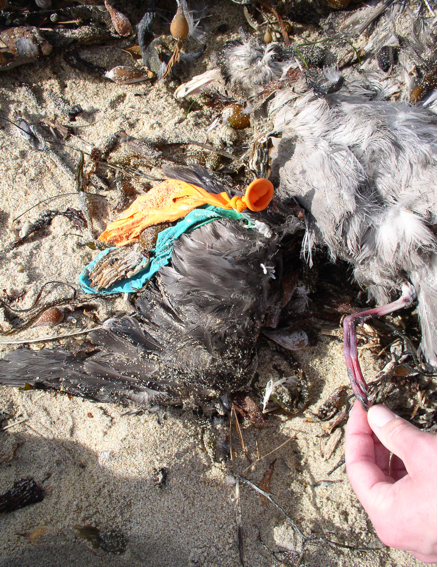
by Danielle Frechette, Vertebrate Ecology Lab
Hi, my name is Danielle. I am a graduate student in the Vertebrate Ecology lab, and I need your help with a problem we are having in our ocean right here off the coast of California. I noticed this problem when I was working on a whale watch boat in Monterey Bay.
The winter months (December through April) is gray whale season here in California. Gray whales spend the summer in Alaska, where they feed in cold, nutrient rich waters. At the end of the summer they head down to Mexico, to give birth to their calves and mate in the warm, shallow waters of Baja California. Here in California we are lucky, because they travel right along our coast on their way to and from Mexico. On February 15th and 16th I was out on the whale watch boat, looking for gray whales. We found whales, but we also found balloons. LOTS of balloons.
Each time we saw a balloon, we stopped the boat, and our deckhand used a gaff hook (a long pole with a hook on the end that is normally used for grabbing the lines we use to tie the boat to the dock) to grab the balloon out of the water. During those two days alone, we picked up 14 balloons! Each balloon was either pink, or a heart shaped Mylar balloon, which means they were all probably released on Valentine’s day, either accidentally or on purpose. We only traveled across a small part of Monterey Bay, and if we had traveled across more of the bay, I do not know how many more we would have found!
Fourteen balloons is a lot to find in only two days. It is not unusual, however, to see one or two balloons on an average day of whale watching in Monterey Bay.

One of the problems with balloons is that they can look a lot like jellies. Animals like endangered sea turtles eat jellies, and they can accidentally eat balloons, thinking they are jellies. This seems surprising, that a balloon could be mistaken for food. More than once though, I have looked over the side of my whale watch boat to see a large jelly floating near the surface, but as we got closer, I
realized that it was not a jelly at all, but a big Mylar balloon. If I, with my human brain, can mistake a balloon for a jelly, it is easy to understand how a hungry turtle can make the same mistake!
I don’t only see balloons out in the ocean. Almost every time I go for a walk on the beach, I see balloons all tangles around kelp, driftwood, and even wildlife, like the northern fulmar in this photograph.
I need you to help me figure out how the balloons get out into the ocean. Also, I need you to help me figure out how the balloons affect wildlife like sea turtles, birds, and marine mammals. I would also like you to help me figure out what we can do to help decrease the number of balloons that make it out into the ocean.
You can use these websites to answer the following questions, and help me keep our oceans free of balloons!
Websites:
http://www.longwood.edu/cleanva/balloons.htm
http://www.mcsuk.org/mcsaction/pollution/balloons
Questions:
1. How do balloons get into the ocean?
2. Give three examples of how marine animals are affected by balloons.
3. What are the laws in California regarding balloons?
4. What can you do to help prevent balloon from harming marine wildlife?

